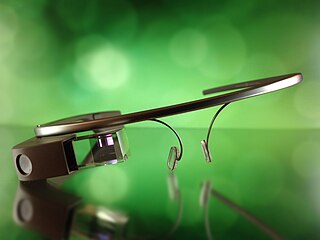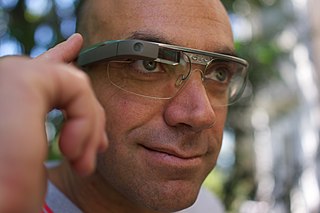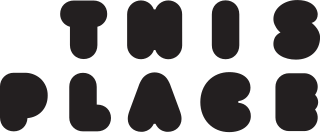
Biofeedback is the technique of gaining greater awareness of many physiological functions of one's own body by using electronic or other instruments, and with a goal of being able to manipulate the body's systems at will. Humans conduct biofeedback naturally all the time, at varied levels of consciousness and intentionality. Biofeedback and the biofeedback loop can also be thought of as self-regulation. Some of the processes that can be controlled include brainwaves, muscle tone, skin conductance, heart rate and pain perception.

A brain–computer interface (BCI), sometimes called a brain–machine interface (BMI) or smartbrain, is a direct communication pathway between the brain's electrical activity and an external device, most commonly a computer or robotic limb. BCIs are often directed at researching, mapping, assisting, augmenting, or repairing human cognitive or sensory-motor functions. They are often conceptualized as a human–machine interface that skips the intermediary component of the physical movement of body parts, although they also raise the possibility of the erasure of the discreteness of brain and machine. Implementations of BCIs range from non-invasive and partially invasive to invasive, based on how close electrodes get to brain tissue.
Alpha waves, or the alpha rhythm, are neural oscillations in the frequency range of 8–12 Hz likely originating from the synchronous and coherent electrical activity of thalamic pacemaker cells in humans. Historically, they are also called "Berger's waves" after Hans Berger, who first described them when he invented the EEG in 1924.

Photo Booth is an application developed by Apple Inc. for the macOS and iPadOS operating systems that allows users to take photos and videos using the device's built-in camera.
NeuroSky, Inc. is a manufacturer of brain-computer interface (BCI) technologies for consumer product applications, which was founded in 2004 in Silicon Valley, California. The company adapts electroencephalography (EEG) and electromyography (EMG) technology to fit a consumer market within a number of fields such as entertainment, education, automotive, and health.
There are various consumer brain–computer interfaces available for sale. These are devices that generally use an electroencephalography (EEG) headset to pick up EEG signals, a processor that cleans up and amplifies the signals, and converts them into desired signals, and some kind of output device.

Electroencephalography (EEG) is a method to record an electrogram of the spontaneous electrical activity of the brain. The biosignals detected by EEG have been shown to represent the postsynaptic potentials of pyramidal neurons in the neocortex and allocortex. It is typically non-invasive, with the EEG electrodes placed along the scalp using the International 10–20 system, or variations of it. Electrocorticography, involving surgical placement of electrodes, is sometimes called "intracranial EEG". Clinical interpretation of EEG recordings is most often performed by visual inspection of the tracing or quantitative EEG analysis.
Mindflex is a toy by Mattel by which, according to its description, the operator uses their brain waves to steer a ball through an obstacle course. Brain waves are registered by the enclosed EEG headset, which allows the user to control an air stream by concentrating, thus lifting or lowering a foam ball. The game was released in the fall of 2009, and uses the same microchip as the MindSet from NeuroSky and homebuilt EEG machines.
The N200, or N2, is an event-related potential (ERP) component. An ERP can be monitored using a non-invasive electroencephalography (EEG) cap that is fitted over the scalp on human subjects. An EEG cap allows researchers and clinicians to monitor the minute electrical activity that reaches the surface of the scalp from post-synaptic potentials in neurons, which fluctuate in relation to cognitive processing. EEG provides millisecond-level temporal resolution and is therefore known as one of the most direct measures of covert mental operations in the brain. The N200 in particular is a negative-going wave that peaks 200-350ms post-stimulus and is found primarily over anterior scalp sites. Past research focused on the N200 as a mismatch detector, but it has also been found to reflect executive cognitive control functions, and has recently been used in the study of language.
Imagined speech is thinking in the form of sound – "hearing" one's own voice silently to oneself, without the intentional movement of any extremities such as the lips, tongue, or hands. Logically, imagined speech has been possible since the emergence of language, however, the phenomenon is most associated with its investigation through signal processing and detection within electroencephalograph (EEG) data as well as data obtained using alternative non-invasive, brain–computer interface (BCI) devices.

Android Ice Cream Sandwich is the fourth major version of the Android mobile operating system developed by Google. Unveiled on October 19, 2011, Android 4.0 builds upon the significant changes made by the tablet-only release Android Honeycomb, in an effort to create a unified platform for both smartphones and tablets. The first phone with Android Ice Cream Sandwich was Samsung Galaxy Nexus.

Google Glass, or simply Glass, is a brand of smart glasses developed and sold by Google. It was developed by X, with the mission of producing a ubiquitous computer. Google Glass displays information to the wearer using a head-up display. Wearers communicate with the Internet via natural language voice commands.
This glossary defines terms that are used in the document "Defining Video Quality Requirements: A Guide for Public Safety", developed by the Video Quality in Public Safety (VQIPS) Working Group. It contains terminology and explanations of concepts relevant to the video industry. The purpose of the glossary is to inform the reader of commonly used vocabulary terms in the video domain. This glossary was compiled from various industry sources.

Smartglasses or smart glasses are eye or head-worn wearable computers that offer useful capabilities to the user. Many smartglasses include displays that add information alongside or to what the wearer sees. Alternatively, smartglasses are sometimes defined as glasses that are able to change their optical properties, such as smart sunglasses that are programmed to change tint by electronic means. Alternatively, smartglasses are sometimes defined as glasses that include headphone functionality.

Pixel Camera, formerly Google Camera, is a camera phone application developed by Google for the Android operating system. Development for the application began in 2011 at the Google X research incubator led by Marc Levoy, which was developing image fusion technology for Google Glass. It was publicly released for Android 4.4+ on the Google Play on April 16, 2014. It was initially supported on all devices running Android 4.4 KitKat and higher, but became only officially supported on Google Pixel devices in the following years. The app was renamed Pixel Camera in October 2023, with the launch of the Pixel 8 and Pixel 8 Pro.

A mind-controlled wheelchair is a motorized wheelchair controlled by a brain–computer interface. Such a wheelchair could be of great importance to patients with locked-in syndrome (LIS), in which a patient is aware but cannot move or communicate verbally due to complete paralysis of nearly all voluntary muscles in the body except the eyes. Such wheelchairs can also be used in case of muscular dystrophy, a disease that weakens the musculoskeletal system and hampers locomotion.
Emotiv Inc. is a privately held bio-informatics and technology company developing and manufacturing wearable electroencephalography (EEG) products including neuroheadsets, software development kits (SDK), software, mobile apps, and data products. Founded in 2011 by Tan Le and Geoff Mackellar, the company is headquartered in San Francisco, U.S.A. with facilities in Sydney, Hanoi and Ho Chi Minh City.

This Place are a digital strategy and design agency, designing sustainable digital businesses that work for customers, for shareholders and for society. Driven by purpose as much as profit, they design websites, apps and digital services used by millions of people. Working with clients across the globe from a London hub, they are part agency, part consultancy and true partner

Android Pie, also known as Android 9 is the ninth major release and the 16th version of the Android mobile operating system. It was first released as a developer preview on March 7, 2018, and was released publicly on August 6, 2018.

The Pixel 4 and Pixel 4 XL are a pair of Android smartphones designed, developed, and marketed by Google as part of the Google Pixel product line. They collectively serve as the successors to the Pixel 3 and Pixel 3 XL. They were officially announced on October 15, 2019 at the Made by Google event and released in the United States on October 24, 2019. On September 30, 2020, they were succeeded by the Pixel 5.










